Ansys HFSS: Multipurpose High Frequency Electromagnetic Field Simulator for RF, Microwave, Advanced Driver Assistance Systems (ADAS), Multipaction, and Electromagnetic Interference and Compatibility (EMI/EMC)
Ansys HFSS is a 3D electromagnetic (EM) simulation software for designing and simulating high-frequency electronic products such as antennas, antenna arrays, RF or microwave components, high-speed interconnects, filters, connectors, IC packages and printed circuit boards. Engineers worldwide use Ansys HFSS software to design high-frequency, high-speed electronics found in communications systems, advanced driver assistance systems (ADAS), satellites, and internet-of-things (IoT) products.
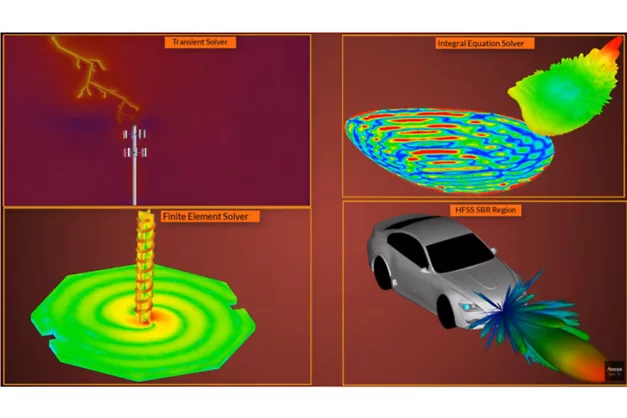
Smarter Antenna Design and Placement Simulation
Antennas are virtually everywhere. From commercial applications such as smartphones, RFID tags, and wireless printers, to defense applications such as phased array antennas for aircraft radar systems or autonomous vehicles, to integrated ground-based communication systems.
Electromagnetic simulation of antenna design and its interaction with the entire system allows designers to evaluate “what if” real life scenarios.
Autonomous Sensor Development: High-Performance Sensor Design for All Conditions
Sensors are critical components that provide the information autonomous vehicles need to make intelligent and safe decisions. They must reliably deliver high performance capabilities and function in a wide range of adverse operating conditions, including rain, ice and snow.
Simulation is proven to enable engineers to improve sensor performance, determine optimal vehicle integration configurations and examine their behavior across a wide range of operational scenarios. With such safety-critical systems, the most accurate, physics-based simulation tools are required. Ansys SPEOS, Ansys AVxcelerate Sensors, and Ansys HFSS provides a comprehensive autonomous vehicle sensor development capability that includes: Lidar, Radar, Camera


Electromagnetic Interference and Compatibility (EMI/EMC)
Electronic systems are often safety or mission critical. They form the backbone of global technology disruptions, from 5G-connected devices to autonomous vehicles and the Internet of Things. As performance requirements increase and electronics proliferate, the risk of interference leading to degraded performance, unintended consequences—or even failure—rises dramatically. With using Ansys HFSS, Slwave and EMA3D , EMI/EMC issues can be resolved in advance, with reduced physical testing to deliver high-performance, safe and compliant designs.
PCB Board Modeling and Simulation
Printed circuit boards (PCBs), ICs and IC packages are used in almost all electronic products across all industries: automotive, A&D, consumer electronics, healthcare and energy. With electronics getting smaller, engineers need to design boards that are smaller than ever and incorporate all the required features. Ansys HFSS, Slwave and Icepak enable us to accurate modeling and simulation of these components as the key to reliable end products with SI, PI and EMI Analysis, Electrothermal Analysis, Shock and Vibration Analysis and Reliability Prediction.
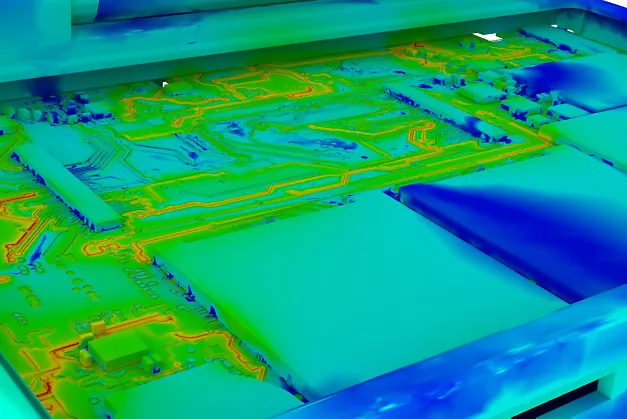
EMI/EMC Analysis
Ansys Electronics Desktop enables engineers to easily combine the unmatched accuracy of Ansys electromagnetic 3D and 2.5D field solvers and the powerful circuit- and system-level solutions in Ansys RF Option to diagnose, isolate and eliminate EMI and radio-frequency issues (RFI) early in the design cycle.
Users can take advantage of the seamless workflow in Electronics Desktop, which includes advanced electromagnetic field solvers, and dynamically link them to power circuit simulators to predict EMI/EMC performance of electrical devices. These integrated workflows avoid repetitive design iterations and costly recurrent EMC certification tests. Multiple EM solvers intended to address diverse electromagnetic problems, as well as the circuit simulators in Electronics Desktop, help engineers assess the overall performance of their electrical devices and create interference-free designs. These diverse problems range from radiated and conducted emissions, susceptibility, crosstalk, RF desense, RF coexistence, cosite, electrostatic discharge, electric fast transients (EFT), burst, lightning strike effects, high intensity fields (HIRF), radiation hazards (RADHAZ), electromagnetic environmental effects (EEE), electromagnetic pulse (EMP) to shielding effectiveness and other EMC applications.
Radio Frequency Interference (RFI) in Complex Environments
EMIT works hand-in-hand with Ansys HFSS to combine RF system interference analysis with best-in-class electromagnetic simulation for modeling installed antenna-to-antenna coupling. The result is a complete solution to reliably predict the effects of RFI in multi-antenna environments with multiple transmitters and receivers.
EMIT’s powerful analysis engine computes all important RF interactions including non-linear system component effects. Diagnosing RFI in complex environments is notoriously difficult and expensive to perform in a testing environment, but with EMIT’s dynamic linked results views, the identification of the root-cause of any interference is rapidly accomplished via graphical signal trace-back and diagnostic summaries that show the exact origin and path that interfering signals take to each receiver. Once the cause of interference is uncovered, EMIT enables rapid evaluation of various RFI mitigation measures in order to arrive at the optimum solution. The new HFSS/EMIT Datalink allows the model for RFI analysis to be created in EMIT directly from the physical 3D model of the installed antennas in HFSS. This provides a seamless end-to-end workflow for a complete RFI solution for RF environments ranging from large platform cosite interference to receiver desense in electronic devices.
Installed Antenna and RF Cosite Analysis
In Ansys HFSS, engineers can simulate infinite and finite phased-array antennas with all electromagnetic effects, including mutual coupling, array lattice definition, finite array edge effects, dummy elements and element blanking, through advanced unit cell simulation.
A candidate array design can examine input impedances of all elements under any beam scan condition. Phased array antennascan be optimized for performance at the element, subarray or complete array level based on element match (passive ordriven) far-field and near-field pattern behavior over any scan condition of interest. Infinite array modeling involves one or more antenna elements placed within a unit cell. The cell contains periodic boundary conditions on the surrounding walls to mirror fields, creating an infinite number of elements. Element scan impedance and embedded element radiation patterns can be computed, including all mutual coupling effects. The method is especially useful for predicting array-blind scan angles that can occur under certain array beam steering conditions. Finite array simulation technology leverages domain decomposition with the unit cell to obtain a fast solution for large finite-sized arrays. This technology makes it possible to perform complete array analysis to predict all mutual coupling, scan impedance, element patterns, array patterns and array edge effects.
RF Systems and Circuits Analysis
When combined with HFSS, circuits and RF systems simulation technologies create an end-to-end high-performance workflow for RF, EMI/EMC and other applications.
It includes EMIT, a unique multi-fidelity approach for predicting RF system performance in complex RF environments with multiple sources of interference. EMIT also provides the diagnostic tools needed to quickly identify root-cause RFI issues and mitigate problems early in the design cycle.
Signal and Power Integrity Analysis
When combined with HFSS, SI Circuits can be used for analyzing signal integrity, power integrity and EMI issues caused by shrinking timing and noise margins in PCBs, electronic packages, connectors and other complex electronic interconnects.
HFSS with SI Circuits can handle the complexity of modern interconnect design from die-to-die across ICs, packages, connectors and PCBs. By leveraging the HFSS advanced electromagnetic field simulation capability dynamically linked to powerful circuit and system simulation, engineers can understand the performance of high-speed electronic products long before building a prototype in hardware.
Encrypted 3D Components
Encrypted 3D Component support in HFSS 3D Layout allows companies to share their detailed component designs (connector, antenna, SMD chip capacitor) without divulging IP such as geometry and material properties.
The ability to simulate encrypted HFSS 3D components means that you no longer need to compromise on accuracy. Designers are no longer forced to use circuit-level components (e.g., S-parameter models) vs. true 3D models into their design, impacting the overall simulation accuracy.
It enables prospective customers of vendors to use encrypted 3D Components in a full system design. The end user receives more confidence in the validity of results by rigorously considering coupling effects of the integration while also protecting the vendor’s design IP. In addition, it also provides full, uncompromised simulation fidelity for encrypted 3D components with HFSS and adaptive meshing delivering its gold-standard accuracy.
Multipaction Simulation: Finite-Element Particle-In-Cell (PIC)
Ansys HFSS has been enhanced with multipaction analysis, which solves for an electronic phenomenon that can cause breakdown due to high electric fields in a vacuum, enhancing solutions for aerospace applications as well as 5G satellites.
HFSS multipaction solver is based on a finite-element particle-in-cell (PIC) method. HFSS provides the multipaction analysis as a postprocessing of the frequency-domain field solutions. With few steps to set up the excitations and boundary conditions for charged particle simulation, you can check whether your design meets the standard for multipaction breakdown prevention.
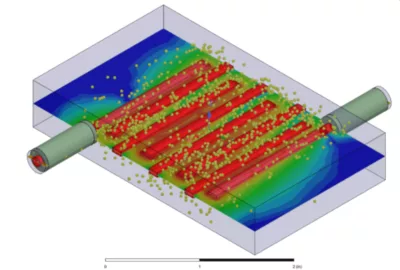
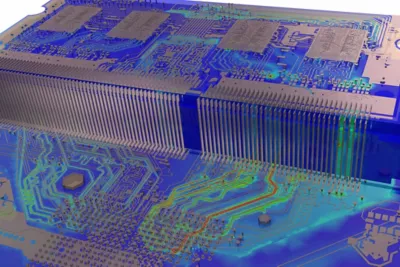

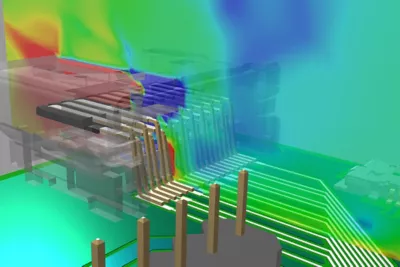

Noise, Vibration & Harshness – NVH for Electric Motors
Electrical Motor Design
Power Transformer: Finite Element Based Design
Electric Motors Cooling
Electromagnetic Multiphysics
Ansys Maxwell: Low-Frequency Electromagnetic Simulation for Electric Machines
Ansys EMA3D Charge/Cable
Predict Charged Plasma Behaviors With EMA3D Charge and its Particle-in-Cell Solver
Battery Thermal Management: Simulation Based Design
Simulation of Plasma Based Devices: Microwave Plasma & RF Plasma with Coupling Particle in Cell (PIC), MHD, CFD and FEA Solvers
NVH & Acoustics for Hybrid & Electric Vehicles
eVTOL (Electric Vertical Take-Off and Landing) & UAM (Urban Air Mobility)
Finite Element Analysis of Durability and Fatigue Life
Acoustics and Vibration: FEA and CFD for AeroAcoustics, VibroAcoustics and NVH Analysis
Integrated Artificial Intelligence (AI) & Machine Learning - Deep Learning with CFD & FEA Simulation
Heat Transfer and Thermal Analysis
WE WORK WITH YOU
We pride ourselves on empowering each client to overcome the challenges of their most demanding projects.
Enteknograte Finite Element Electromagnetic Field simulation solution which uses the highly accurate finite element solvers and methods such as Ansys Maxwell, Simulia CST & Opera, JMAG, Cedrat FLUX, Siemens MAGNET and COMSOL to solve static, frequency-domain, time-varying electromagnetic and electric fields includes a wide range of solution types for a complete design flow for your electromagnetic and electromechanical devices in different industries.




